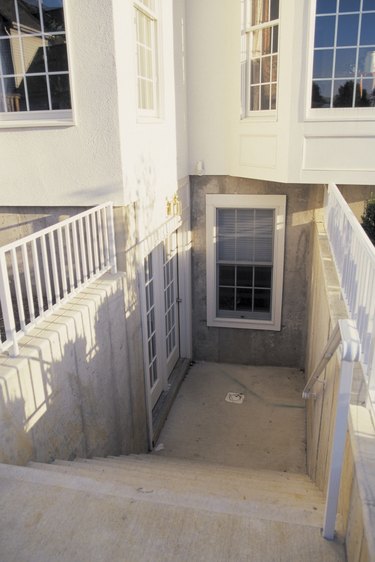
Heat flow is the natural phenomenon by which hot air moves to cold regions. Air leaks in basements and attics, in particular, lead to substantial heat loss by letting hot air out of the home while permitting cold air to enter. Weatherproofing the home helps prevent heat loss, lowering the energy output and cost of heating systems. Caulking basement windows is an important part of weatherproofing.
Caulking Basics
Video of the Day
Caulking around basement windows serves two purposes -- it prevents cold air from entering the house and stops warm air from leaking out. You can purchase caulk at any hardware store or home improvement retailer, along with the caulk gun to apply it. The caulk gun offers the homeowner more accuracy in terms of applying a bead of caulk around the outside of the window, creating a seal where it meets the exterior walls. You can also seal the inside of the window for extra protection. Caulk expands upon exposure to air and forms an airtight seal.
Video of the Day
Types of Caulk
There are many types of caulk, each made from a different basic ingredient. Health and Energy, a Nebraska-based environmental health and home energy testing agency, recommends the use of masonry caulk around windows to form an optimal bond with the stonework around basement windows. If you need caulk to form a bond with non-masonry material, such as wood or metal, use silicone-based caulks, which work best with metal and glass and are ideal for weatherproofing.
Considerations
Permanent caulk creates a better seal than temporary caulk for the purposes of weatherproofing. However, if you open your basement windows during the spring, summer and/or fall, use temporary caulk for easy removal. Using caulk that blends with the coloring of your home adds aesthetic appeal to a caulked window. Be aware that while silicone-based caulks may provide the best seal, they contain toxic chemicals. Water-based caulks, such as latex and acrylic, contain no toxic chemicals and are easier to work with than silicone-based caulks because they prove more malleable and clean easily with water. Silicone-based caulks require solvent-based cleaners and, if overused, may expand enough to warp the material of a window frame. Furthermore, you can rip latex or acrylic caulks with your hand when adjusting your seal -- silicone-based caulks require tools for removal or alteration.
Additional Weatherproofing Techniques
There are other methods of weather-proofing your home besides using caulk. Many homeowners cover sunken basement windows with well covers. These are large pieces of plastic that attach to exterior basement walls and sit on the ground, preventing cold air, rain and snow from entering the area around the windows. Other weather-proofing options include foam sealants to plug holes in masonry material around basement windows. For additional protection on old, single-pane glass windows, they can be covered with plastic sheeting.